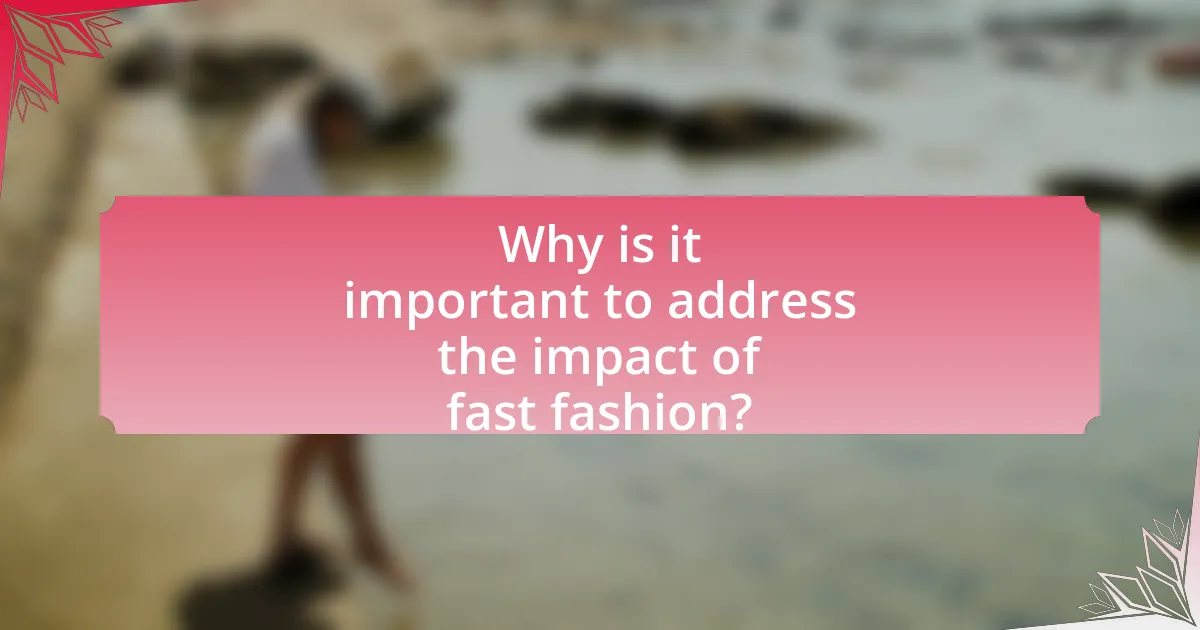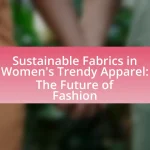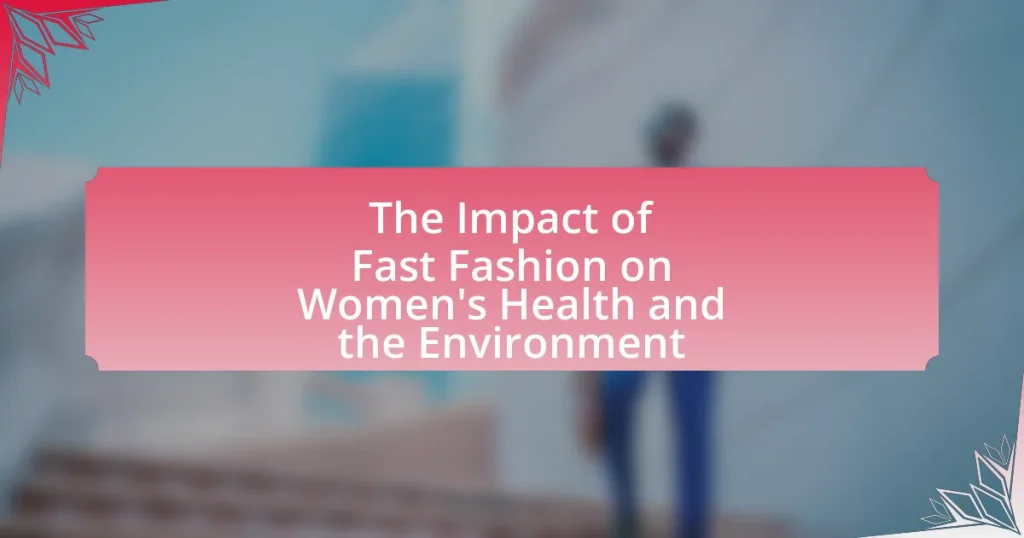The article examines the significant impact of fast fashion on women’s health and the environment, highlighting the detrimental effects of harmful labor practices and pollution associated with the industry. It details how women, who constitute a large part of the garment workforce, face unsafe working conditions and exposure to toxic chemicals, leading to various health issues. Additionally, the article discusses the environmental consequences of fast fashion, including excessive waste, high carbon emissions, and water pollution, while emphasizing the need for sustainable practices and consumer awareness to mitigate these impacts. The role of consumers in perpetuating the fast fashion cycle and the ethical implications of supporting such brands are also explored, alongside potential solutions for promoting a more responsible fashion industry.
What is the Impact of Fast Fashion on Women’s Health and the Environment?
Fast fashion negatively impacts women’s health and the environment by promoting harmful labor practices and contributing to pollution. Women, who make up a significant portion of the garment workforce, often face unsafe working conditions, exposure to toxic chemicals, and low wages, leading to physical and mental health issues. For instance, a report by the World Health Organization highlights that exposure to hazardous substances in textile production can result in respiratory problems and skin diseases among workers. Environmentally, fast fashion contributes to significant waste and pollution; the Ellen MacArthur Foundation states that the fashion industry is responsible for 10% of global carbon emissions and is the second-largest consumer of water, exacerbating climate change and depleting natural resources.
How does fast fashion affect women’s physical health?
Fast fashion negatively affects women’s physical health primarily through exposure to harmful chemicals and poor-quality materials. Many fast fashion garments are produced using toxic substances such as azo dyes, formaldehyde, and phthalates, which can lead to skin irritations, respiratory issues, and long-term health problems. For instance, a study published in the journal Environmental Science & Technology found that these chemicals can leach into the skin, causing allergic reactions and other health complications. Additionally, the low-quality fabrics often used in fast fashion can lead to discomfort and physical ailments, such as musculoskeletal issues from poorly fitting clothing.
What are the health risks associated with fast fashion clothing materials?
Fast fashion clothing materials pose several health risks, primarily due to the use of toxic chemicals in their production. These materials often contain harmful substances such as azo dyes, formaldehyde, and phthalates, which can lead to skin irritations, allergic reactions, and respiratory issues. For instance, a study published in the journal Environmental Science & Technology found that many fast fashion garments release hazardous chemicals that can be absorbed through the skin or inhaled, increasing the risk of long-term health problems. Additionally, the production processes often involve exposure to pesticides and heavy metals, further exacerbating health risks for workers and consumers alike.
How does the fast fashion industry contribute to mental health issues among women?
The fast fashion industry contributes to mental health issues among women primarily through the promotion of unrealistic beauty standards and the pressure to constantly update wardrobes. This industry often utilizes marketing strategies that emphasize thinness, youth, and perfection, leading to body image dissatisfaction among women. Research indicates that exposure to such ideals can increase anxiety, depression, and low self-esteem. For instance, a study published in the journal “Body Image” found that women who frequently engage with fashion media report higher levels of body dissatisfaction and depressive symptoms. Additionally, the fast-paced nature of fast fashion encourages a cycle of consumption that can lead to financial stress and feelings of inadequacy, further exacerbating mental health challenges.
What environmental consequences arise from fast fashion practices?
Fast fashion practices lead to significant environmental consequences, including increased textile waste, water pollution, and high carbon emissions. The fast fashion industry produces approximately 92 million tons of waste annually, with a large portion ending up in landfills. Additionally, the production processes often involve toxic dyes and chemicals that contaminate water sources, affecting aquatic ecosystems and human health. Furthermore, the industry is responsible for around 10% of global carbon emissions, contributing to climate change. These facts illustrate the detrimental impact of fast fashion on the environment.
How does fast fashion contribute to pollution and waste?
Fast fashion contributes to pollution and waste primarily through the rapid production and disposal of clothing, which generates significant environmental harm. The industry is responsible for approximately 10% of global carbon emissions, largely due to the energy-intensive processes involved in manufacturing and transporting garments. Additionally, fast fashion leads to massive textile waste; around 92 million tons of textiles are discarded annually, with a large portion ending up in landfills. The use of synthetic fibers, such as polyester, exacerbates this issue, as these materials can take hundreds of years to decompose and release microplastics into ecosystems during their lifecycle. Furthermore, the chemical dyes and treatments used in fast fashion contribute to water pollution, affecting aquatic life and human health.
What are the effects of fast fashion on biodiversity and ecosystems?
Fast fashion significantly harms biodiversity and ecosystems by promoting unsustainable production practices that lead to habitat destruction, pollution, and resource depletion. The rapid turnover of clothing encourages the use of synthetic materials, which contribute to microplastic pollution in oceans, affecting marine life. Additionally, the agricultural practices for cotton and other fibers often involve harmful pesticides and fertilizers, which degrade soil health and contaminate water sources. According to the United Nations Environment Programme, the fashion industry is responsible for 10% of global carbon emissions, exacerbating climate change and its impact on ecosystems. Furthermore, the excessive water consumption in textile production threatens freshwater resources, endangering aquatic ecosystems and biodiversity.

Why is it important to address the impact of fast fashion?
Addressing the impact of fast fashion is crucial because it significantly contributes to environmental degradation and poses health risks to women. Fast fashion leads to excessive waste, with an estimated 92 million tons of textile waste generated annually, which often ends up in landfills. Additionally, the production processes involve harmful chemicals that can affect the health of workers, predominantly women, who are exposed to toxic substances. Studies indicate that these chemicals can lead to serious health issues, including reproductive problems and skin diseases. Therefore, recognizing and addressing these impacts is essential for promoting sustainable practices and protecting both the environment and women’s health.
What role do consumers play in the fast fashion cycle?
Consumers drive the fast fashion cycle by creating demand for inexpensive, trendy clothing. Their purchasing behavior encourages brands to produce large quantities of low-cost garments, leading to rapid turnover of styles and increased production rates. According to a 2021 report by the Ellen MacArthur Foundation, the average consumer now buys 60% more clothing than in 2000, contributing to a significant rise in textile waste and environmental degradation. This demand influences brands to prioritize speed and cost over sustainable practices, exacerbating negative impacts on both women’s health and the environment.
How can consumer choices influence the fast fashion industry?
Consumer choices significantly influence the fast fashion industry by driving demand for inexpensive, trendy clothing. When consumers prioritize low prices and rapid turnover of styles, brands respond by increasing production, often at the expense of ethical labor practices and environmental sustainability. For instance, a report by the Ellen MacArthur Foundation highlights that the fast fashion sector contributes to 92 million tons of waste annually, largely due to consumer habits favoring disposable fashion. Additionally, a survey by McKinsey & Company found that 66% of consumers are willing to pay more for sustainable brands, indicating that shifting preferences towards sustainability can compel fast fashion companies to adopt more responsible practices.
What are the ethical implications of supporting fast fashion brands?
Supporting fast fashion brands raises significant ethical implications, primarily related to labor exploitation and environmental degradation. Fast fashion often relies on low-wage labor in developing countries, where workers face poor working conditions, long hours, and minimal rights. For instance, a 2018 report by the Ethical Trading Initiative highlighted that many garment workers earn less than the living wage, which perpetuates poverty and social inequality.
Additionally, fast fashion contributes to severe environmental harm, including pollution and waste. The United Nations Environment Programme reported that the fashion industry is responsible for 10% of global carbon emissions and is a major contributor to water pollution due to toxic dyeing processes. This environmental impact disproportionately affects marginalized communities, particularly women, who often bear the brunt of pollution-related health issues.
In summary, the ethical implications of supporting fast fashion brands encompass labor rights violations and significant environmental consequences, both of which have profound effects on women’s health and the broader community.
How can awareness of fast fashion’s impact lead to change?
Awareness of fast fashion’s impact can lead to change by prompting consumers to make more sustainable purchasing decisions. When individuals understand that the fast fashion industry contributes to significant environmental degradation, such as the release of 1.2 billion tons of greenhouse gases annually, they are more likely to seek eco-friendly alternatives. Additionally, awareness can drive demand for ethical labor practices, as many fast fashion brands exploit workers, particularly women, in developing countries. This shift in consumer behavior can encourage brands to adopt sustainable practices and improve labor conditions, ultimately fostering a more responsible fashion industry.
What initiatives exist to promote sustainable fashion alternatives?
Various initiatives exist to promote sustainable fashion alternatives, including the Fashion Revolution movement, which advocates for transparency in the fashion supply chain and encourages consumers to ask brands “Who made my clothes?” Additionally, the Sustainable Apparel Coalition works to reduce the environmental and social impacts of apparel and footwear products through the Higg Index, a standardized measurement tool. Furthermore, organizations like the Ellen MacArthur Foundation focus on circular economy principles, promoting the recycling and repurposing of materials in fashion. These initiatives collectively aim to foster a more sustainable fashion industry by raising awareness, encouraging responsible consumer behavior, and implementing industry-wide standards.
How can education about fast fashion influence purchasing decisions?
Education about fast fashion can significantly influence purchasing decisions by increasing consumer awareness of its environmental and social impacts. When individuals understand that fast fashion contributes to pollution, waste, and unethical labor practices, they are more likely to choose sustainable alternatives. For instance, a study published in the Journal of Consumer Research found that consumers who received information about the negative effects of fast fashion were 30% more likely to opt for eco-friendly brands. This shift in purchasing behavior demonstrates that informed consumers prioritize sustainability over low-cost, low-quality garments.
What are the solutions to mitigate the impact of fast fashion on women’s health and the environment?
Solutions to mitigate the impact of fast fashion on women’s health and the environment include promoting sustainable fashion practices, encouraging the use of eco-friendly materials, and advocating for ethical labor practices. Sustainable fashion practices, such as upcycling and thrifting, reduce waste and lower the demand for new clothing production, which is often linked to harmful chemicals that can affect women’s health. The use of eco-friendly materials, like organic cotton and recycled fabrics, minimizes environmental degradation and exposure to toxic substances. Additionally, advocating for ethical labor practices ensures that workers are treated fairly and work in safe conditions, which can improve overall community health. According to the Ellen MacArthur Foundation, transitioning to a circular economy in fashion could reduce greenhouse gas emissions by 44% by 2030, highlighting the potential environmental benefits of these solutions.
What sustainable practices can consumers adopt?
Consumers can adopt several sustainable practices to mitigate the impact of fast fashion on women’s health and the environment. These practices include purchasing second-hand clothing, which reduces waste and resource consumption, as evidenced by the fact that buying used clothing can save up to 27,000 liters of water per garment compared to new production. Additionally, consumers can choose to buy from brands that prioritize sustainable materials and ethical labor practices, as research indicates that sustainable brands often use organic or recycled materials, which have a lower environmental footprint. Furthermore, consumers can practice mindful consumption by limiting impulse purchases and focusing on quality over quantity, which contributes to a decrease in textile waste, with the average American discarding about 81 pounds of clothing each year. By implementing these practices, consumers can significantly reduce their ecological footprint and promote a healthier environment.
How can women support ethical fashion brands?
Women can support ethical fashion brands by choosing to purchase from companies that prioritize sustainable practices and fair labor conditions. By researching brands that are transparent about their supply chains and materials, women can make informed decisions that align with their values. For instance, a study by the Ethical Fashion Forum indicates that consumers who prioritize ethical considerations can drive significant change in the fashion industry, as their purchasing power influences brand practices. Additionally, women can advocate for ethical fashion by sharing information on social media, participating in campaigns that promote sustainable practices, and supporting local artisans who create ethically made products.
What are the benefits of second-hand shopping and clothing swaps?
Second-hand shopping and clothing swaps significantly reduce environmental impact by minimizing waste and resource consumption. By purchasing pre-owned items, consumers help divert clothing from landfills, where textile waste contributes to pollution and greenhouse gas emissions. According to the Environmental Protection Agency, in 2018, 11.3 million tons of textile waste were generated in the U.S. alone. Clothing swaps further promote sustainability by encouraging community engagement and reducing the demand for new clothing production, which is often linked to harmful practices in the fast fashion industry. This shift not only supports eco-friendly habits but also fosters a sense of community and shared responsibility for the environment.
How can policymakers address the issues related to fast fashion?
Policymakers can address the issues related to fast fashion by implementing regulations that promote sustainable practices within the fashion industry. For instance, they can enforce stricter environmental standards that limit waste and pollution generated by textile production, as the fashion industry is responsible for 10% of global carbon emissions. Additionally, policymakers can incentivize brands to adopt circular economy principles, encouraging recycling and the use of sustainable materials. Evidence from the Ellen MacArthur Foundation indicates that transitioning to a circular economy could reduce fashion’s environmental impact by 70% by 2030. Furthermore, implementing consumer education campaigns can raise awareness about the health risks associated with fast fashion, such as exposure to harmful chemicals in clothing. By combining regulatory measures, incentives, and education, policymakers can effectively mitigate the negative impacts of fast fashion on women’s health and the environment.
What regulations can be implemented to reduce the environmental impact of fast fashion?
Regulations that can be implemented to reduce the environmental impact of fast fashion include mandatory sustainability reporting, stricter waste management laws, and the enforcement of eco-design principles. Mandatory sustainability reporting requires brands to disclose their environmental impact, promoting transparency and accountability. Stricter waste management laws can limit textile waste by mandating recycling and responsible disposal practices, as the fashion industry contributes to 92 million tons of waste annually. Eco-design principles encourage the creation of products that minimize environmental harm throughout their lifecycle, aligning with the European Union’s Circular Economy Action Plan, which aims to make sustainable products the norm by 2030.
How can governments support sustainable fashion initiatives?
Governments can support sustainable fashion initiatives by implementing policies that promote eco-friendly practices and incentivize sustainable production methods. For instance, they can provide tax breaks or grants to companies that adopt sustainable materials and processes, thereby encouraging the industry to shift away from fast fashion practices that harm the environment. Additionally, governments can establish regulations that require transparency in supply chains, ensuring that brands disclose their environmental impact and labor practices. Research from the Ellen MacArthur Foundation indicates that transitioning to a circular economy in fashion could generate $560 billion in economic benefits, highlighting the potential for government involvement to drive significant change.
What practical steps can individuals take to reduce their fast fashion consumption?
Individuals can reduce their fast fashion consumption by adopting sustainable shopping habits. This includes buying fewer, higher-quality garments that are made to last, which can significantly decrease the demand for fast fashion products. Research indicates that the average consumer buys 60% more clothing than in 2000 but keeps each item for half as long, contributing to environmental degradation. Additionally, individuals can choose to shop second-hand or vintage, which extends the lifecycle of clothing and reduces waste. Engaging in clothing swaps with friends or community groups also promotes reuse and minimizes the need for new purchases. Lastly, educating oneself about brands’ ethical practices and supporting companies that prioritize sustainability can further diminish reliance on fast fashion.














